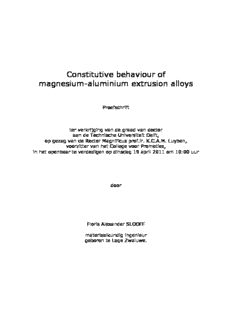
Constitutive behaviour of magnesium-aluminium extrusion alloys PDF
Preview Constitutive behaviour of magnesium-aluminium extrusion alloys
Constitutive behaviour of magnesium-aluminium extrusion alloys Proefschrift ter verkrijging van de graad van doctor aan de Technische Universiteit Delft, op gezag van de Rector Magnificus prof.ir. K.C.A.M. Luyben, voorzitter van het College voor Promoties, in het openbaar te verdedigen op dinsdag 19 april 2011 om 10:00 uur door Floris Alexander SLOOFF materiaalkundig ingenieur geboren te Lage Zwaluwe. Dit proefschrift is goedgekeurd door de promotor: Prof. ir. L. Katgerman Copromotor: Dr. J. Zhou Samenstelling promotiecommissie: Rector Magnificus, voorzitter Prof. ir. L. Katgerman, Technische Universiteit Delft, promotor Dr. J. Zhou, Technische Universiteit Delft, copromotor Prof. dr. K.U. Kainer, Technische Universiteit Hamburg Prof. dr. D.J. Schipper, Universiteit Twente Prof. dr. ir. L.A.I. Kestens, Technische Universiteit Delft , Universiteit Gent Prof. dr. I.M. Richardson, Technische Universiteit Delft Prof. ir. F. Soetens, Technische Universiteit Eindhoven Keywords: wrought magnesium alloy, deformation, constitutive analysis, hot working, extrusion. ISBN: 978-94-6108-157-5 Copyright © 2011 by F.A. Slooff All rights reserved. No part of the material protected by this copyright notice may be reproduced or utilized in any form or by any means, electronic or mechanical, including photocopying, recording or by any information storage and retrieval system, without the prior written permission from the author. Printed in the Netherlands To those I love Table of Contents Chapter 1. Introduction 1.1 Introduction 1 1.2 Background, application and future 2 1.3 Alloyed magnesium 6 1.4 Deformation mechanisms of magnesium 10 1.5 Hot working thermomechanical simulation 14 1.6 Thesis outline 20 1.7 References 20 Chapter 2. Experimental set-up and data processing of uniaxial hot compression tests for constitutive analysis 2.1 Introduction 25 2.2 Experimental set-up for uniaxial hot compression tests 26 2.3 Data correction and processing 30 2.4 Conclusions 37 2.5 References 38 Chapter 3. Constitutive analysis of wrought magnesium-aluminium alloys 3.1 Introduction 41 3.2 Constitutive behaviour of AZ61 42 3.3 Development of strain dependent constitutive analysis 54 3.4 Strain dependent constitutive analysis of AZ41, AZ61 and AZ80 60 3.5 Conclusions 70 3.6 References 71 (cid:1) i Chapter 4. Hot workability analysis of extruded AZ magnesium alloys with processing maps 4.1 Introduction 75 4.2 Processing maps 76 4.3 Compression tests and microstructure analysis 79 4.4 Results and discussion 80 4.5 Conclusions 102 4.6 References 103 Chapter 5. Prediction of pressure required to extrude a wrought magnesium alloy using optimized strain dependent constitutive parameters 5.1 Introduction 107 5.2 Extrusion modelling 108 5.3 Compression and extrusion experiments of AZ41 111 5.4 Predicting the extrusion pressure for various profile shapes 114 5.5 Conclusions 121 5.6 References 122 Chapter 6. Conclusions and recommendations 6.1 Introduction 125 6.2 Conclusions 126 6.3 Recommendations 127 Summary 131 Samenvatting 135 List of publications 141 Dankwoord 143 Curriculum vitae 145 (cid:1) ii (cid:1) iii (cid:1) iv Chapter 1 Introduction 1.1 Introduction Because of their high strength-to-weight ratio, wrought magnesium alloys have a great potential for various applications where mass reduction is desired. By increasing the use of magnesium alloys in the automotive industry, for example, CO emissions will be reduced, thereby making a 2 positive impact on the environment. However, the peculiar deformation behaviour of most magnesium alloys has so far limited their applications. Due to the difficulties to deform many wrought magnesium alloys, high extrusion pressures are required and an unacceptable surface quality is likely to develop. Finding a proper window of processing, realizing an optimum microstructure and being able to preset processing parameters on a rational basis will all help in expanding the utilization of these promising materials. Chapter 1 1.2 Background, application and future Magnesium alloys have a great potential for various applications. In the past, cast alloys have been put into numerous automotive applications due to their low density combined with the high specific stiffness and strength. Developing wrought magnesium alloys will increase the applicability of this group of materials in modern automobiles. Table 1.1 gives a brief overview of the differences between magnesium and the two other common structural metallic materials: aluminium and steel. The main differences can be found in the crystal structure (and therefore the slip planes available for deformation) and the specific strength, which is the ratio of yield strength to density. The table clearly shows that the specific strength of magnesium is superior to that of aluminium or steel. Table 1.1. Comparison of material properties between magnesium, aluminium and steel. Property Magnesium Aluminium Steel Hexagonal Face Body closed centred centred Crystal Structure packed cubic cubic (hcp) (fcc) (bcc) Density at RT [*103 kg/m3] 1.74 2.70 7.86 Thermal Expansion Coefficient 25.2 23.6 11.7 [*106/°C] Melting Point [°C] 650 660 1536 Elastic Modulus [GPa] 44 69 207 Tensile Strength [MPa] 260 310 800 Yield Strength [MPa] 200 275 600 Specific Strength [GPa*m3kg-1] 115 102 76 To illustrate the properties given in Table 1.1, a comparison between the weight and stiffness of different materials is given in Figure 1.1. The figure shows that when beams of equal weight are compared, magnesium- 2
Description: